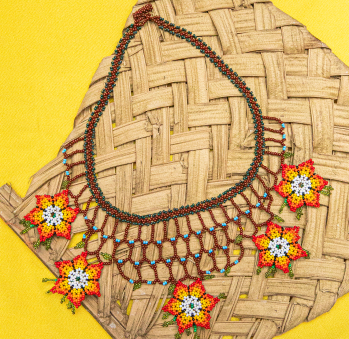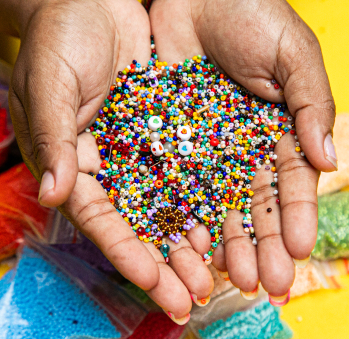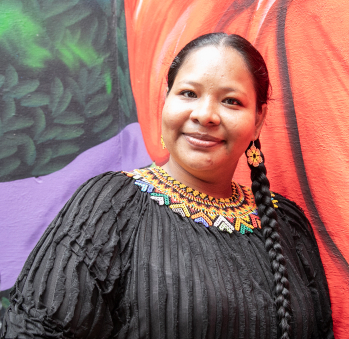Estefania Arrieta
Workshop: Arte Sikuani
Craft: Tejeduría
Trail: Arauca Route
Location: Arauca, Arauca
Estefanía Arrieta speaks with a command that most people acquire at an older age. At just 26 years old, she has left her community and returned, raised three children, and discovered the profound value of weaving accompanied by others, particularly within the group she is part of, where she has mentored many. Estefanía understands the deep significance of her craft, which emanates from her heart.
Her journey into beaded weaving began eight years ago, a skill she learned from her mother at the Indigenous Sikuani Reservation of El Zamuro. After observing her mother weaving for a while, Estefanía grew curious and inquired about the craft. Her mother shared that she had learned it from her own mother and continued practicing it because it was a part of their customs. She mentioned that she found better concentration during late evenings, after working in the fields in the morning. Moreover, she revealed that most times, her dreams guided her creations—dictating what to weave next and the colors to use. Weaving brought peace and tranquility to her mother, who, in her limited Spanish, explained that whenever she had a tangle stuck in her mind, she would release it into her work, often finding solutions while crafting. The answer would often emerge upon completing a woven piece.
While her mother prefers mountainous colors, such as earth brown and sky blue, Estefanía is drawn to vibrant hues. Her joyful personality translates into her choice of colors. She feels happiest when weaving and delights in infusing her creations with life through vibrant shades. When feeling low, she refrains from weaving to avoid imbuing her creations with discomfort. Through her journey as a craftswoman, she has learned to infuse her creations with positivity and present them devoid of negative emotions. Sometimes, when she has a new idea, she works alone to bring it to life before presenting it to the other women in the group, who may or may not appreciate it. She becomes so engrossed in her work that she forgets to eat, only remembering when someone sits beside her to have a meal. Conversely, when she visits her community on weekends, she weaves alongside other women, fostering conversations and knowledge-sharing. This group comprises fifteen women aged between 10 and 65. Their work has even inspired men in their community, who have formed their own group of weavers.
It’s certain that more men and women will gather the courage to learn weaving and join a group within the El Zamuro community, which consists of approximately 180 families involved in artisanal goods and honey production. Inspiration thrives in this territory, from the lush trees to crops of corn, plantains, cane, mangoes, as well as seasonal fruits like mandarins, oranges, mamones, soursops, papayas, pineapples, and guavas. The land speaks to them, just as it did to Estefanía’s young cousin, who has started weaving and has already depicted their home in a beaded bracelet: two huts, a corn plant, the sun, and a boy.
Initially, Estefanía struggled to communicate with customers and explain the intent behind each woven piece, often hiding behind her mother. However, she realized that nobody else could convey the true essence of her work. Presently, she encourages her peers to overcome their shyness and share their expertise. She is the only one who can articulate the meaning behind her bracelets, like the one she named “”My Emotions,”” which embodies as many colors as she has emotions. Currently, she focuses on incorporating golden beads in her creations, influenced by the idea of light and the radiance that illuminates a moment, visible from afar.
Craft




















Artisans along the way
Artisans along the way
No puede copiar contenido de esta página





























































